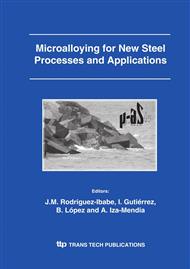[1]
On the Road in 2020, A life-cycle analysis of new automotive technologies. MIT Energy Laboratory Report, October 2000, on line at http: /www. mit. edu.
Google Scholar
[2]
Joseph F. Toot Jr.: Components Analyst, issue n°36, Feb. (1997).
Google Scholar
[3]
F. Wasservogel: «Les matériaux dans l'automobile : vers une répartition nouvelle des rôles entre clients et fournisseurs». La Révue de Métallurgie - CIT (1994), p.1415.
DOI: 10.1051/metal/199491101415
Google Scholar
[4]
F.B. Pickering Physical metallurgy and the design of steels,. Ed. Applied Science Publishers, London, UK (1978).
Google Scholar
[5]
F. Mudry, A. Le Bon and R. Bulthé « Les aciers : hier, aujourd'hui et demain » La Revue de Métallurgie-CIT novembre (2004), p.957.
Google Scholar
[6]
Microalloying '95. Proc. of the Int. Conf. Held under the auspices of the Iron and Steel Society Pittsburgh, PA, USA (June 11-14, 1995).
Google Scholar
[7]
Proc. of THERMEC 1997, 7th-11 th July 1997, Univ. of Wollogong, Australia. Pub. By TMS, 420 Commonwealth Drive, Warrendale, PA, USA.
Google Scholar
[8]
Proc. of µ-aS98 Microalloying in Steels , San Sebastian 7th-9th Sept. (1998).
Google Scholar
[9]
Niobium Science & Technology. Proc. of the Int. Symp. Niobium 2001, December 2-5, 2001, Orlando, Florida, USA. Pub. By Niobium 2001 Ltd. & TMMS.
Google Scholar
[10]
Proc. of THERMEC 2003, 7th-11 th July 2003, Universidad Carlos III, Madrid-Leganés, España. Pub. By Trans Tech Publications, Switzerland. Material Science Forum Vols. 426- 432, on line at http: /www. scientific. net.
Google Scholar
[11]
J. Rofes Vernis and D. Robat: Engineering Steels for the Automotive Industry - Long micro-alloy steel products, Proceedings of an Automotive Steel Seminar jointly organized by ЦНИИчерМет (Bardin Inst. ) & CBMM-NPC. Moscow 17th -18th Feb. 2004 (bilingual English-Russian edition).
Google Scholar
[12]
M. Assefpour-Dezfuly and A. Brownrigg: Metall. Trans. Vol. 20A (1989), p. (1951).
Google Scholar
[13]
M. Shimotsusa, N. Ibaraki, T. Ikeda and T. Nakayama: Wire Jour. Int. (March 1998), p.78.
Google Scholar
[14]
T. Kimura and Y. Kurebayashi: in.
Google Scholar
[15]
W. Heitmann, T.G. Oakwood and H.J. Dziembala: in.
Google Scholar
[16]
M. Langa and A. Ouakka: Mec. Ind. 2(2001), p.181.
Google Scholar
[17]
J. Mougin, A. Mostacchi and Y. Hersart : Proc. of EUROCORROSION 2004, paper 409, Nice, France, Sept. (2004).
Google Scholar
[18]
J.P. Lebrun et al. : « Bilan d'un four de cémentations avancées après deux ans d'utilisation » ATTT 2000. 1er Congrès Européen du Traitement Thermique et Mécanique des Surfaces. 14- 16 juin Metz (France).
Google Scholar
[19]
C. Pichard, D. Forest, D. Robat, L. Poirier, J.P. Lebrun and B. Edenhofer : 4-6 Neue Lösungen für die Aufkohlungstechnologien mit Hochdruckgasab-schreckung durch angepasste Stahlmetallurgie" 56 Härterei Kolloquium, 4-6 Okt. 2000. Wiesbaden. Deutschland.
Google Scholar
[20]
J.L. Pacheco and G. Krauss: HTM 45 (1990) n°2, p.77.
Google Scholar
[21]
W. Bleck and F. Hippenstiel: Microalloying in Case Hardening Steels" Proc. of HSLA 2000, 30 Oct. - 2 Nov. Xi, an (China).
Google Scholar
[22]
ECSC final report n° 7210-PR/103 on Development of carburising steels for ultra high process temperatures, (2003).
Google Scholar
[23]
W. Bleck et al.: « New Developments for Microalloyed Heat Treating Steels" in.
Google Scholar
[24]
B. Garbarz and F.B. Pickering: Mat. Sci. & Technology Vol. 4 (1988), p.117.
Google Scholar
[25]
I. Aldaturriaga, J. Bas and M. Ortolland: Proc. of ATTT, Le Mans (sept. 1990).
Google Scholar
[26]
J. Schmid et al.: VW Unpublished research report (Nov. 1983).
Google Scholar
[27]
K. Hulka: 20th National Convention of M&MS, Jamshedpur, India (1995).
Google Scholar
[28]
First of the three Hume-Rothery rules for solid solutions: A.H. Cottrell Theoretical Structural Metallurgy, Edward Arnold Ltd. London, U.K. (1965 Ed. ), p.128.
Google Scholar
[29]
B. Serin, Y. Desalos, Ph. Maitrepierre and J. Rofes-Vernis: Mem. Sci. Rev. Mét. No. 75, June 1975; (Charles Hatchett Award 1980).
Google Scholar
[30]
C. Fossaert, G. Rees, T. Maurickx and H.K.D.H. Bhadeshia: Met. Mat. Transactions A Vol. 26A (1995), p.21.
Google Scholar
[31]
E.J. Palmiere, C.I. Garcia and A.J. DeArdo: Met. Mat. Transactions A Vol. 25A (1994), p.277.
Google Scholar


